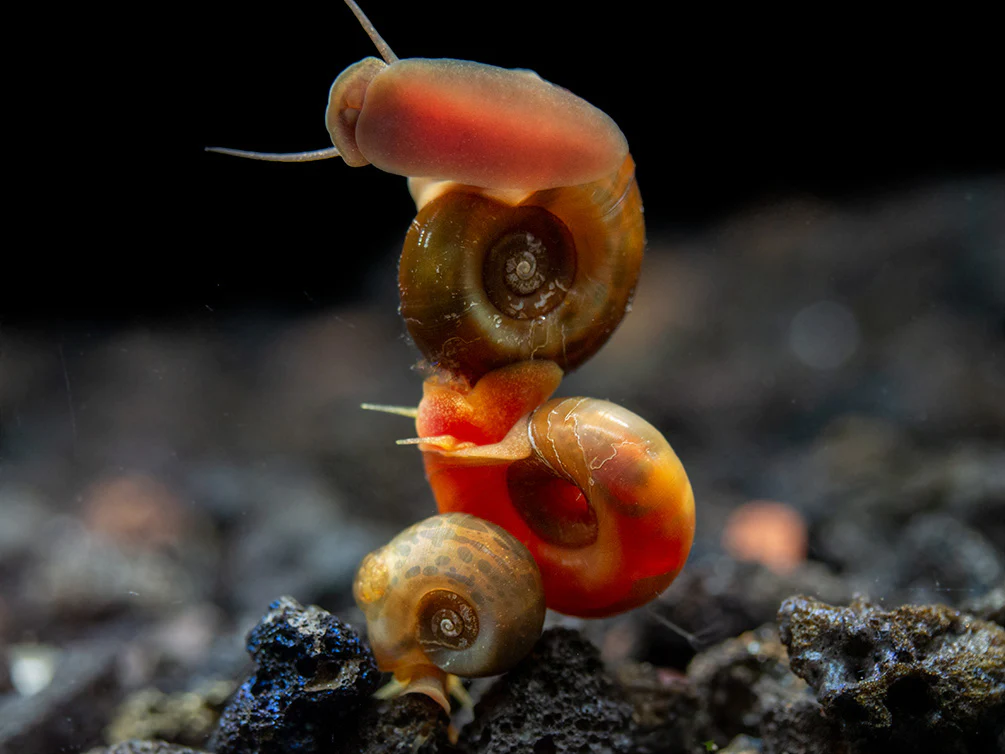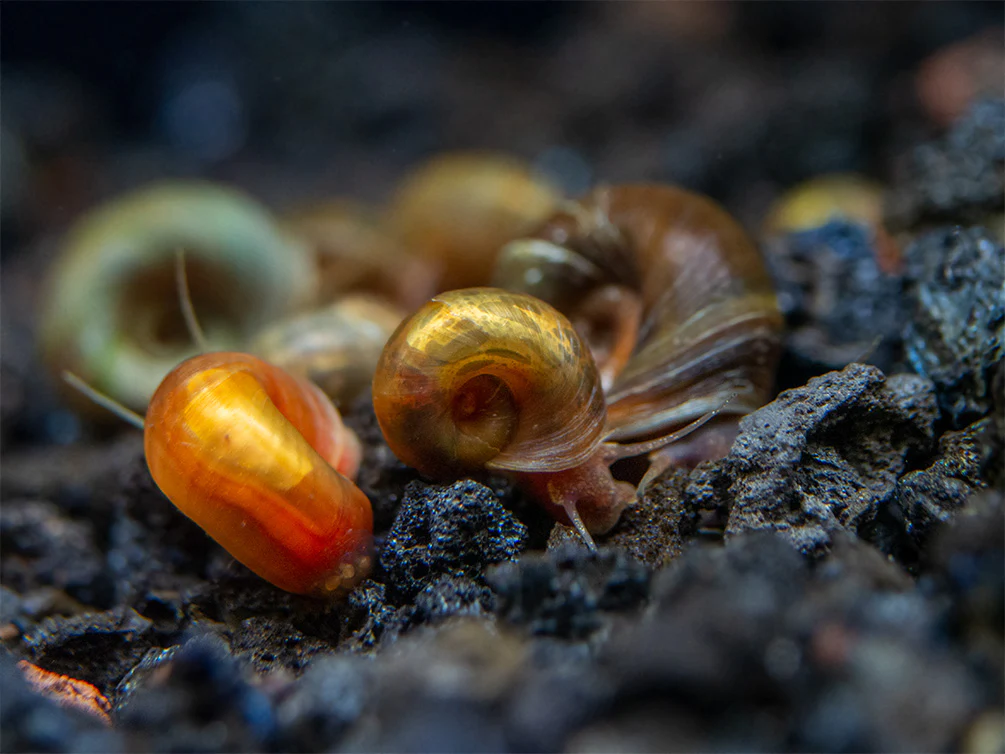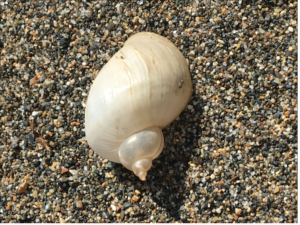What’s your next addition to the aquarium? Consider the Ramshorn snail – this colorful freshwater snail reproduces rapidly and in large numbers. It’s also known for its huge appetite, making it an effective cleaner for pond algae.
Ramshorn snails eat algae, decaying food, and plants. They are peaceful and can be housed with non-aggressive fish or gastropods in a 4-gallon tank with pH 7.0-7.5, temperatures of 21-26°C (70-78°F), and water hardness of 5-15 KH. However, their potential to spread parasites should be considered.
This comprehensive guide demystifies the ramshorn snail by exploring its origins, habitat, appearance, diet, breeding, temperament, prices, and common problems. This guide is suitable for beginners and seasoned aquarists unfamiliar with ramshorn snails.
Ramshorn Snail Origin and Natural Habitat
| Ramshorn Snail Species | Natural Habitat |
| Common Ramshorn Snail | Ponds, streams, swamps, and lakesSlow-moving or stagnant water with ample aquatic life |
| Marsh Ramshorn Snail | Endemic to the southeastern United States Found in freshwater ecosystems like ponds and streams |
| Great Ramshorn | Western Europe, Central Europe, Siberia |
| Seminole Ramshorn | Endemic to southeastern United States |
| Colombian Giant Ramshorn | Freshwater ecosystems as their habitat Native to Central America Requires gills for respiration Belongs to the Ampullariidae family Grows up to 4 inches (10 cm) in diameter |
The ramshorn snail belongs to the Planorbidae snail family, which falls under the class Gastropoda and subclass Pulmonata. These freshwater snails are air-breathing and do not have gills, relying on lungs for respiration.
Related Reading: Can Snails Breathe Underwater?
Ramshorn snails are native to North and South America, with different species occupying various habitats. One commonly found species is the marsh rams-horn (Planorbis trivolvis), which is endemic to the southeastern United States.
Another widely reared species is the great ramshorn (Planorbarius corneus), found in Western Europe, central Europe, and Siberia.
The Seminole ramshorn (Planorbella duryi) is another common species endemic to freshwater ecosystems in the southeastern United States.
An exceptional member of the ramshorn family is the Colombian giant ramshorn snail (Marisa cornuarietis), which breathes through gills and belongs to the Ampullariidae family along with mystery snails. This species, growing up to 4 inches (10 cm) in diameter, is native to Central America.
This guide, however, focuses on the common and Seminole ramshorn snails since they are the most commonly found in pet stores worldwide.
In the wild, the common ramshorn snail inhabits the following:
- Ponds
- Streams
- Swamps
- Lakes
It prefers slow-moving or stagnant water where sufficient aquatic life exists to provide food for the snail.
Ramshorn Snail Appearance and Color

In the wild, ramshorn snails typically have a brown to dark coloration. However, due to commercial breeding efforts, a wide range of colors is now available.
The most commonly found varieties in pet stores include:
- Blue
- Pink
- Red
- Leopard
Young ramshorn snails have translucent bodies with a golden hue, which becomes more solid as they mature.
The bright reddish color seen in young snails is actually their blood, which fades as they develop and their color solidifies.
The shell of a ramshorn snail is conical but flattened, resembling a flat disk or a twisted rope spiral. This unique and visually appealing shell shape is one of the reasons why people are drawn to these snails. It is from this distinctive shell appearance that they derive their name.
One fascinating aspect of ramshorn snails is their ability to exhibit various body and shell colors. The color possibilities for ramshorn snails seem limitless.
Ramshorn Snail Size
Ramshorn snails are small creatures, typically measuring around 1 inch (2½ cm) in diameter.
However, the quality of care they receive greatly influences their size, and achieving a diameter larger than 1 inch is considered impressive.
These snails generally reach a maximum length of a quarter of an inch, similar in size to a dime.
Ramshorn Snail Lifespan
A ramshorn snail typically has an average lifespan of about 1 year. However, with special care, the ramshorn snail’s lifespan can be extended to around 2 years.
To achieve this longer lifespan, aquarists must provide the following:
- Stable living conditions.
- High-quality food.
- Protect the snails from any potential shocks.
Prolonged exposure to toxic environments or suboptimal conditions can drastically reduce their lifespan to just a few months.
Ramshorn Snail Care
Caring for ramshorn snails is relatively straightforward, especially for aquarists with experience handling other lunged snails.
The key aspects to consider are:
- Tank size
- Water parameters
- Compatible tank mates
- Diet
- Breeding conditions
These factors play a crucial role in ensuring the well-being of ramshorn snails.
Tank Size
The minimum recommended tank size for a single ramshorn snail is 5 gallons (19 liters). While you can keep multiple ramshorn snails in this tank, it’s crucial to ensure they have enough space and the tank doesn’t become overcrowded.
For aquarists interested in keeping ramshorn snails with fish, a tank size of 10-12 gallons (38-45 liters) is ideal.
I recommend the Aqueon 10 Gallon Rectangular Tank from Amazon for aquariums and terrariums. It features high-quality glass construction with clean silicone-sealed edges, ensuring durability and aesthetic appeal.
| Preview | Product | |
|---|---|---|

|
Aqueon Standard Glass 10 Gallon Rectangular Tank for Aquariums & Terrariums | Check Price |
The Lifegard Aquatics 10 Gallon Aquarium is also a great option due to its clear glass construction and quality craftsmanship. With dimensions of 20.07” x 9.84” x 12.60” and a 5mm glass thickness, it provides a spacious and durable environment for your aquatic pets.
| Preview | Product | |
|---|---|---|

|
Lifegard Aquatics 10 Gallon Rimless Clear Glass Aquarium 5mm (20.07″x9.84″x12.60″) | Check Price |
Although ramshorn snails are not known for being adept escape artists, it is still recommended to keep the tank covered. This precaution helps ensure the snails remain safely contained within the aquarium.
Habitat
Ramshorn snails thrive in lively environments with a variety of healthy aquarium plants. These plants contribute to the snail’s diet and enhance the tank’s overall liveliness.
Snails enjoy nibbling and interacting with the plants, so it’s crucial to ensure that any plants introduced to the tank are free from snail eggs to avoid overpopulation.
Some suitable aquarium plants that you may consider include:
Hornwort (Ceratophyllum demersum)
I recommend the Xpress Ecommerce Aquarium Plant Hornwort from Amazon. Each bunch has multiple stems ranging from 3 to 7 inches (8-18 cm). Please note that the plants may appear wilted, brown, or damaged upon arrival due to transit, but they will recover within a few days.
| Preview | Product | |
|---|---|---|

|
Aquarium Plant Hornwort Coontail Bunch 2-3 Stems | Check Price |
Red Root Floater (Phyllanthus luitans)
I recommend the Canton Aquatics 30+ Red Root Floater from Amazon. This sought-after plant features beautiful hanging red roots and leaves that turn deep red under high lighting. It promotes high water quality by removing nitrates and can be an excellent food source for ramshorn snails.
Amazon Sword (Echinodorus sp)
I recommend the Greenpro Red Diamond Amazon Sword from Amazon. This potted live aquarium plant has a sturdy root system for efficient nutrient absorption and provides a beautiful background cover for your tank. It enhances water quality and offers shelter to your ramshorn snails, ensuring a vibrant and healthy environment.
| Preview | Product | |
|---|---|---|

|
Echinodorus Sp Red Diamond Amazon Sword Potted Tall Background Live Aquarium Plants Decoration… | Check Price |
Java Moss (Vesicularia dubyana)
I recommend the Aquatic Arts Java Moss from Amazon. This loose portion bunch provides enough moss to create a mat covering 25 square inches or more. It thrives in any freshwater aquarium, offering biofilm, hiding places, and security for young snails.
| Preview | Product | |
|---|---|---|

|
Aquatic Arts Java Moss (Large 25 Square Inch Portion) Freshwater Aquarium Plants | Java Moss Live… | Check Price |
Common Duckweed (Lemna minor)
I recommend DBDPet Live Duckweed Plants from Amazon. This hardy and free-floating plant is rich in protein and is loved by koi. It can thrive in various aquatic environments with low to moderate lighting, making it a versatile and beneficial addition to your aquarium.
| Preview | Product | |
|---|---|---|

|
200 Live Duckweed Plants (Lemina Minor) by DBDPet | Live Arrival Guaranteed | Check Price |
It is important to note that ramshorn snails may feed on plant leaves when underfed, particularly soft and unhealthy drying leaves. However, if you properly feed your ramshorn snails, you should have little to worry about them feeding on plants.
Consider introducing substrates to create a more appealing tank environment for ramshorn snails. These snails can adapt well to both soft and hard substrates.
Adding one or two stones can be excellent, as ramshorn snails enjoy sticking to hard surfaces while scavenging for algae.
Be cautious not to overcrowd your tank with excessive plants and substrates.
Water Parameters
Ramshorn snails generally prefer slow-moving clear waters but can also adapt to faster currents.
The ideal water parameters for ramshorn snails are as follows:
| Water Parameters | Recommended Range |
| Water temperature | 21-26 °C (70-78°F) |
| pH levels | 7.0 to 7.5 |
| Water hardness | 5 to 15 dKH |
| Lighting | Normal community tank lighting |
While ramshorn snails do not require extraordinary conditions, they do appreciate consistency. Rapid changes in tank conditions can cause stress and potentially lead to the snail’s death.
To maintain consistency, it is recommended to regularly conduct parameter tests.
I recommend the SJ WAVE 7 in 1 Aquarium Test Kit from Amazon. It provides fast and accurate results by testing pH, Chlorine, General Hardness, Carbonate Hardness, Nitrate, Nitrite, and Temperature. With easy-to-use testing strips and a detailed color chart, you can quickly detect water problems and ensure the well-being of your fish.
| Preview | Product | |
|---|---|---|

|
SJ WAVE 7 in 1 Aquarium Test Kit for Freshwater Aquarium | Fast & Accurate Water Quality Testing… | Check Price |
Ramshorn Snail Diet
The ramshorn snail spends most of its time on the hard surfaces of the tank, searching for food. It primarily feeds on the following:
- Soft green algae found on substrates.
- Decorations.
- Tank walls.
The snail can also burrow a few millimeters beneath the substrate to reach soft brown algae. Additionally, it sustains itself on the following:
- Dead decaying plant matter.
- Fallen tank mates.
- Uneaten food.
To prevent ramshorn snails from consuming tank plants, you can introduce soft vegetable leaves to their diet. However, avoid overfeeding them; excess decaying food can increase the bioload.
Related Reading: Do Snails Increase Bioload?
Provide only as much food as the snails can consume within an hour. For proper nutrition, consider supplementing your snails’ diet with artificial supplements such as:
- Algae wafers.
- Calcium pellets.
- Fish flakes.
- Bottom feeder tablets.
Calcium is crucial for shell growth.
Related Reading: Can You Use Repti Calcium for Snails?
I have observed that ramshorn snails tend to feed in groups. When one snail discovers food in the tank, others join the feast. This group behavior contributes to the snails’ voracious appetite.
Ramshorn Snail Breeding
Ramshorn snail breeding can be challenging for most aquarists due to their voracious appetite, which leads to rapid and uncontrolled reproduction.
Like many other snails, ramshorn snails are hermaphrodites, meaning each snail possesses both male and female sex organs.
After a complex mating process, the “female” snail will lay egg clutches resembling jelly-like globs on the hard surfaces of the tank. These clutches contain about a dozen round sections, each containing a dot.
Approximately a week later, these dots hatch into tiny, seemingly transparent ramshorn snails. Each snail can go through this reproduction cycle at least twice a month.
In a tank with multiple ramshorn snails, uncontrolled reproduction can result in the presence of up to 10 dozen snails.
The simplest way to regulate their reproduction is by managing your feeding program, as the more the snails eat, the more they reproduce.
To learn more about reproduction in snails, read this comprehensive article.
Tank Mates
The ramshorn snail is known for its peaceful and tranquil nature. Its primary defense mechanism is retracting into its shell.
However, it’s important to note that this snail species lacks an operculum, which means it cannot wholly seal itself inside its shell.
Therefore, it is best to choose non-aggressive fish and snail species as tank mates for the ramshorn snail.
Here are some suitable tank mates:
- Cory Catfish
- Otocinclus Catfish
- Bamboo Shrimp
- Amano Shrimp
- Ghost Shrimp
- Red Cherry Shrimp
- Nerite Snails
- Gold Inca Snails
- Ivory Snails
- Mystery Snails
- Trumpet Snails
As long as the tank environment is suitable, ramshorn snails will peacefully coexist with all of these tank mates.
However, there are some known unsuitable tank mates for the ramshorn snail, such as goldfish and Betta fish. These fish species will seize the opportunity to eat the ramshorn snail.
Ramshorn Snail Temperament and Behavior
The ramshorn snail is known for its docile and non-aggressive nature, preferring to be left alone. It spends most of its time scavenging for food and not disturbing other tank mates.
When faced with a threat, the snail coils itself into its shell. This behavior makes it an ideal companion for fish and other snails in the tank.
Buying Ramshorn Snail
Finding ramshorn snails for sale is generally straightforward, but choosing healthy ones can be challenging. It’s essential to look for active snails constantly moving, wiggling, and feeding in the tank.
Ramshorn snails are known for their high activity levels, continuously exploring the tank day and night for food. If you come across a floating ramshorn snail, it should raise concerns as it may indicate an issue.
Shell health is another crucial factor to consider when selecting ramshorn snails. The condition of the shell reflects the overall health of the snail.
Opt for a ramshorn snail with a thick, uncracked, and unpitted shell. A healthy shell is an indicator of a healthy snail.
Ramshorn Snail Common Problems
When it comes to ramshorn snails, the concern lies not in the diseases they may suffer from but in the diseases they may introduce to your tank. This snail species is highly resilient but notorious for carrying diseases into the tank ecosystem.
One common problem is the presence of parasitic skin flukes that ramshorn snails can bring from pet stores. These parasites pose a significant threat to fish as they attach themselves to the fish, hindering their breathing and feeding.
Unfortunately, due to their small size, these parasites often go unnoticed until it’s too late.
Related Reading: Can Snails Get Fish TB?
Closing Remarks
Although the ramshorn snail may be small, its potential should not be underestimated. Aquarists are increasingly drawn to these charming creatures for their beauty and easy maintenance. With proper snail care, they can thrive effortlessly.
Moreover, their ability to clear algae should not be overlooked. The primary challenges you may encounter with these snails are their rapid reproduction and the potential for disease transmission.
Nevertheless, the ramshorn snail is a worthwhile choice, particularly for beginner aquarists, and is definitely worth considering.




